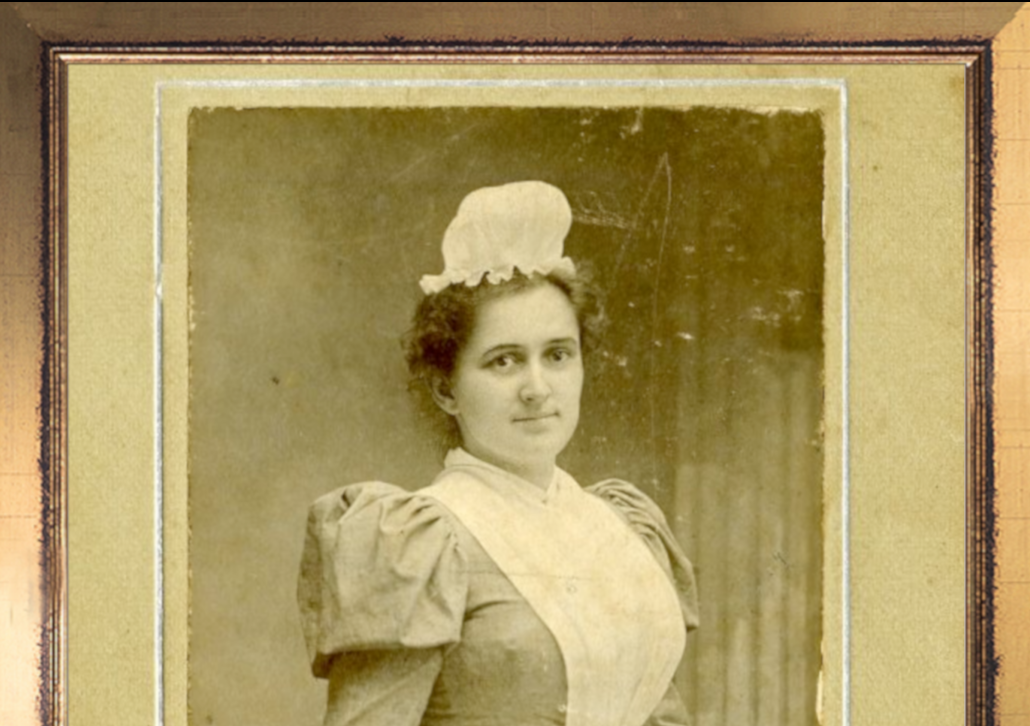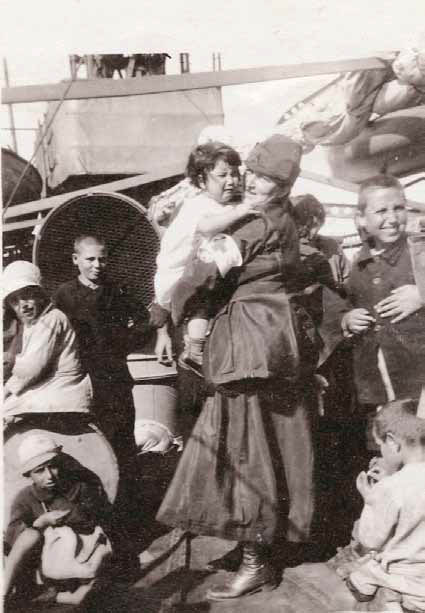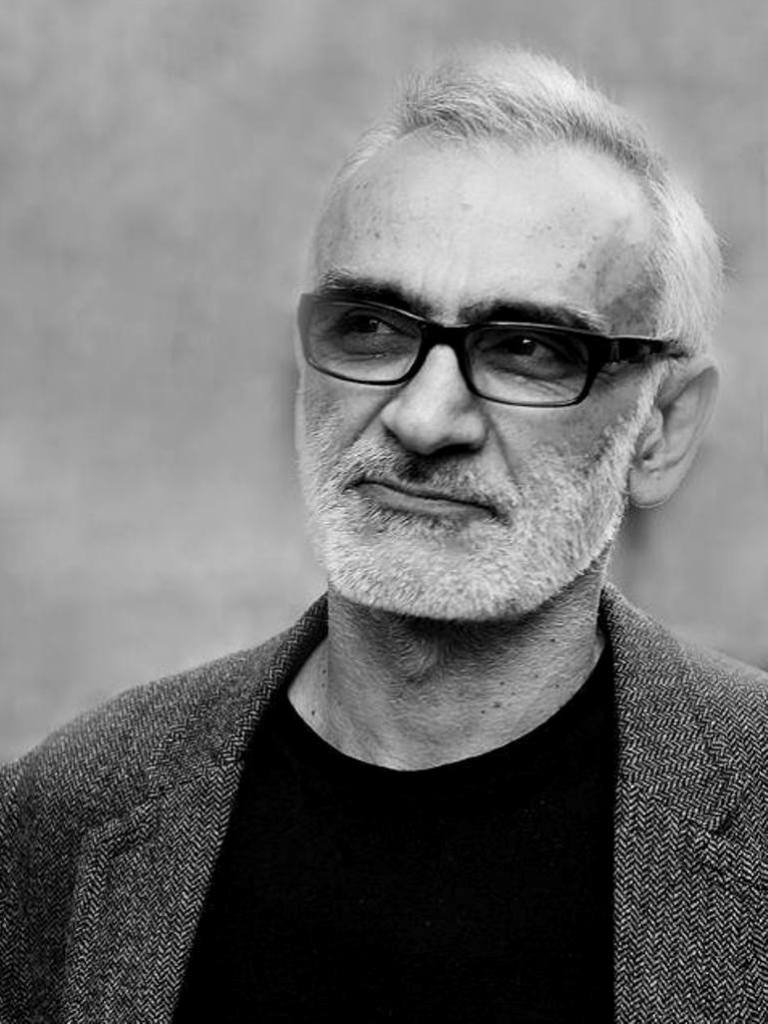Sara Corning. Photo courtesy of the Sara Corning Society.
By Rupen Janbazian
David and Jennifer Chown of the Sara Corning Society provide details about the Sara Corning statue unveiling in Yarmouth, Nova Scotia
Born in the village of Chegoggin, Nova Scotia, Canada, in 1872, Nurse Sara Corning made it her life’s mission to help others. In her mid-twenties, she moved to the United States for training and worked in New England for almost 20 years, before returning to Nova Scotia to help the 10,000 victims of the Halifax Explosion.
In 1918, at the age of 46, Sara was certified by the American Red Cross and joined Near East Relief—an organization created to help civilians affected by the Great War. Landing in Constantinople (Istanbul) soon after, she helped rescue and care for thousands of Armenian and Greek orphans, often risking her life in the process, for more than a decade.
In 2016, nearly a century after Corning’s heroic decision to dedicate her life to help genocide survivors, David and Jennifer Chown of Nova Scotia founded the Sara Corning Society, which honors the nurse’s life and humanitarian work. A number of activities honoring Corning, including the unveiling a statue dedicated to her, will be taking place this weekend in Yarmouth, Nova Scotia.
I recently spoke with David and Jennifer to learn more about what is in store.
***
Rupen Janbazian: How did the idea of establishing the Society come about?
Jennifer Chown: As we became more aware of Sara’s Red Cross volunteer service in Armenia, the former Ottoman Empire and Greece, we gradually realized how significant her service turned out to be. From 1919 to 1930, she saved and cared for thousands of orphaned children and adult refugees.
R.J.: How did you two get involved?
J.C.: I reached out to the mayor of Yarmouth to suggest that a street be named in honor of Sara Corning. In meeting with other interested individuals, we agreed that Sara was as deserving of a statue as any war hero or humanitarian. The Sara Corning Society was formed not long after that with 12 members.
R.J.: How is the Society governed and run? Does it have a paid staff or run strictly with volunteers?
J.C.: We are a not-for-profit corporation made up of 12 members in Yarmouth, Dartmouth and Fall River, Nova Scotia. My husband and I are the founders and co-chairs.
R.J.: Tell us how the idea of erecting a monument in the humanitarian’s honor transpired.
J.C.: A statue seemed to best suit how to honor Sara’ s memory because it underscores the importance of her story for this generation, as well as the one she helped to care for, and including the generations yet to come. A timeless story of someone who stepped out of their comfort zone to help others. This is worth preserving in a lasting way. It also helps to uncover a relatively unknown historical connection between Canada and Armenia—with opportunities for even greater collaboration now. We hope there will be a Canadian embassy established in Armenia soon.
R.J.: How was the site chosen?
David Chown: There were several sites offered but this site was special for several reasons. First of all, her archival holdings are in the adjacent museum. The statue site is where the Zion Baptist Church once stood—a church, which Sara would have attended, like a “mother church” to smaller local Baptist churches—but it was recently demolished due to structural weakness.
In a sacred way, Sara’s statue will now bring a healing presence to the site for local residents. The Yarmouth County Museum and Archives has been a great partner with the Sara Corning Society in efforts to bring this together so we are pleased that the statue will now be owned by them.
R.J.: Tell us a little about the artist commissioned to create the statue.
D.C.: Renowned artist and sculptor Garen Bedrossian from Montreal and Yerevan has invested his heart and soul into this statue. We can feel the heartbeat of Armenia in this initiative—when he sculpted and formed Sara’s image in the city where she first arrived in 1919 to help set up orphanages and hospitals for the thousands of orphans at that time. Garen’s work reflects his Armenian roots and Sara would have been deeply touched that someone from the country and people she came to know so well, created a statue in her honor 100 years later.
J.C.: We would also like to acknowledge the generous donors of the statue, Simon and Maral Hasserjian of Toronto, whose vision to show their gratitude for Sara’s service on behalf of Armenians has now brought our communities together in a deeply personal and beautiful way.
R.J.: A host of activities honoring Corning, including the unveiling statue, will be taking place this weekend. Tell us more about what is planned.
J.C.: The weekend of commemorating Sara Corning will begin on September 13 with a staged reading of a play titled “Memories of Sara Corning” written by Christine Bolger and performed by Martha Irving. The statue of Sara Corning with children will be unveiled at 1 p.m. on September 14 at the Yarmouth County Museum lawn. The Sara Corning Commemorative Dinner will be held that evening at the Rodd Grand Hotel. Other events include an art show at the Waterfront Gallery and a workshop at the Art Gallery of Nova Scotia, Yarmouth branch. Additional details of the events are on our Facebook page.
R.J.: It is well known that Corning was quite humble—so much so that those who knew her well didn’t know the extent to which she affected humanity. If alive today, do you think she would want to be honored and recognized in such grandiose fashion or would she perhaps feel uncomfortable getting all this attention?
J.C.: When Sara arrived home from the Near East, she would have been sensitive to the orphans that she cared for. There were fears of reprisals at that time and she would want to protect them by being silent. As a result, few Nova Scotians have known about her. Also, in any theater of war or post-war eras, it was difficult to describe what those who served would have witnessed and she would have seen the worst of humanity as well as the best of humanity—all at the same time. She was a strong woman with strong faith, there is no doubt of that. She would not have sought recognition as she will be receiving today, but there is no question that she would be pleased—no, elated—to know that people from her area of birth are meeting and developing friendships with the descendants of the ancestors who she would have helped to rescue and care for. We believe she would be very pleased and honored to know this.
R.J.: Any future plans for the Society?
D.C.: We are working through a lengthy process to have Sara Corning named as a National Historic Person by Parks Canada. We are seeking funding support for a nurses’ scholarship in Sara Corning’s name at the Yarmouth campus of the Dalhousie School of Nursing in Yarmouth. A small memorial community park in the tiny Chegoggin village where Sara was raised and later where she retired is being planned to honor Sara’s memory. It is adjacent to the cemetery where she is buried which is also near her home.
J.C.: In addition, the Town of Yarmouth and the Armenian Ambassador to Canada are interested in pursuing a sister-city partnership between Yarmouth and a municipality in Armenia.
D.C.: We see opportunities for initiating Corning Conferences in a world that needs to learn more about genocide education. Sara herself once wrote: “We believe that education is what all nations need to advance.”
The Sara Corning Centre for Genocide Education in Toronto, founded by Raffi Sarkissian and named after Sara, has made great strides in introducing genocide education into the school curriculum in Ontario. We would like to see further outreach for this nationwide. Including speaking engagements about Sara Corning, the research is ongoing and we have additional projects, which are in the works. Her story reaches across a broad spectrum of topics, which are all relevant today.



